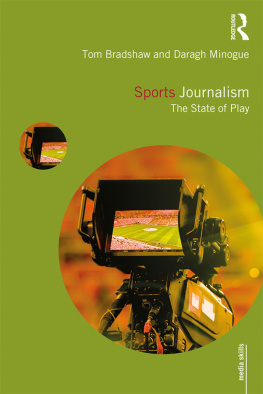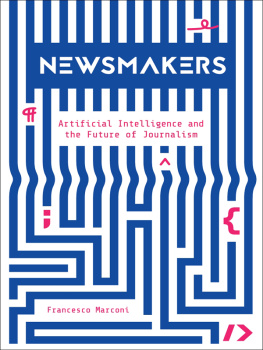
Journalism Design
Journalism Design wrestles with fundamental questions of how journalism should respond to changing technology and human behaviour. It focuses on improving understanding of how users acquire and interact with news in the digital world and how news organisations can better design that experience. Classic journalism storytelling and presentation were dictated by the needs of the telegraph and typesetting equipment. Skye Doherty offers prototypes that reveal intriguing new approaches for improving contemporary value and fostering effective news delivery with digital technologies.
Robert G. Picard, Professor, Reuters Institute for the Study of Journalism, University of Oxford, UK
Journalism Design is about the future of journalism. As technologies increasingly, and continually, reshape the way we interact with information, with each other and with our environment, journalists need new ways to tell stories.
Journalists often see technology as something that improves what they are doing or that makes it more convenient. However, the growing might of technology companies has put journalism and news organisations in a difficult position: readers and revenues have moved, and platforms exert increasing control over story design. Skye Doherty argues that, rather than adapting journalism to new technologies, journalists should be creating the technologies themselves and those technologies should be designed for core values such as the public interest. Drawing from theories and practices of interaction design, this book demonstrates how journalists can use their expertise to imagine new ways of doing journalism. The design and development of the NewsCube, a three-dimensional storytelling tool, is detailed, as well as how interaction design can be used to imagine new forms of journalism. The book concludes by calling for closer ties between researchers and working journalists and suggests that journalism has a hybrid future in newsrooms, communities, design studios and tech companies.
Skye Doherty is a lecturer in Journalism at the University of Queenslands School of Communication and Arts. Her research and teaching straddle journalism and interaction design.
Disruptions: Studies in Digital Journalism
Series editor: Bob Franklin
For a full list of titles in this series, please visit:
www.routledge.com/Disruptions/book-series/DISRUPTDIGJOUR
Disruptions refers to the radical changes provoked by the affordances of digital technologies that occur at a pace and on a scale that disrupts settled understandings and traditional ways of creating value, interacting and communicating both socially and professionally. The consequences for digital journalism involve far-reaching changes to business models, professional practices, roles, ethics, products and even challenges to the accepted definitions and understandings of journalism. For Digital Journalism Studies, the field of academic inquiry which explores and examines digital journalism, disruption results in paradigmatic and tectonic shifts in scholarly concerns and prompts reconsideration of research methods, theoretical analyses and responses (oppositional and consensual) to such changes, which have been described as being akin to a moment of mind blowing uncertainty.
Routledges new book series, Disruptions: Studies in Digital Journalism, seeks to capture, examine and analyse these moments of exciting and explosive professional and scholarly innovation which characterise developments in the day-to-day practice of journalism in an age of digital media and which are articulated in the newly emerging academic discipline of Digital Journalism Studies.
Fake News: Falsehood, Fabrication and Fantasy in Journalism
Brian McNair
Journalism Design: Interactive Technologies and the Future of Storytelling
Skye Doherty
Journalism Design
Interactive Technologies and the Future of Storytelling
Skye Doherty
First published 2018
by Routledge
2 Park Square, Milton Park, Abingdon, Oxon OX14 4RN
and by Routledge
711 Third Avenue, New York, NY 10017
Routledge is an imprint of the Taylor & Francis Group, an informa business
2018 Skye Doherty
The right of Skye Doherty to be identified as author of this work has been asserted by her in accordance with sections 77 and 78 of the Copyright, Designs and Patents Act 1988.
All rights reserved. No part of this book may be reprinted or reproduced or utilised in any form or by any electronic, mechanical, or other means, now known or hereafter invented, including photocopying and recording, or in any information storage or retrieval system, without permission in writing from the publishers.
Trademark notice: Product or corporate names may be trademarks or registered trademarks, and are used only for identification and explanation without intent to infringe.
British Library Cataloguing-in-Publication Data
A catalogue record for this book is available from the British Library
Library of Congress Cataloging-in-Publication Data
A catalog record for this book has been requested
ISBN: 978-1-138-05113-3 (hbk)
ISBN: 978-1-315-16840-1 (ebk)
Typeset in Times New Roman
by Apex CoVantage, LLC
This book and the research and design artefacts underpinning it would not have been possible without the support, guidance and help of others.
First, to Stephen Viller and John Harrison, who supervised the PhD thesis that formed the basis of this book: I am grateful to you both for your sage advice and ongoing encouragement over several years. Thanks also to the thesis examiners, who provided critical and valuable feedback.
The prototypes described here were made possible thanks to the study participants and later with the creative and technical abilities of Andrea Epifani and David Lloyd, who invested many hours developing the NewsCube beta version. The creation of that tool, and subsequent release of open source code, was made possible by a Walkley Grant for Innovation in Journalism. Thanks to the team at the Walkley Foundation for their support, and to the team at iLab, who gave valuable guidance on pitching for the money. Thanks also to the Journalism Design students whose projects are discussed here.
I must thank Bob Franklin and the editorial team at Routledge for their support of the book proposal and its subsequent production. Also thanks to the anonymous reviewers for their feedback. The draft manuscript was read critically by colleagues at the University of Queensland: Jane Johnston and Tom ORegan. Thank you both for your time and insights; the book is better for your input.
I must also acknowledge the ongoing support and friendship of the members of the University of Queenslands interaction design research group.
Finally, thanks to Mark and Gabriel, who have supported my work over many years and never tired of listening to me talk about it.
Thank you everyone.
HCI | human-computer interaction |








